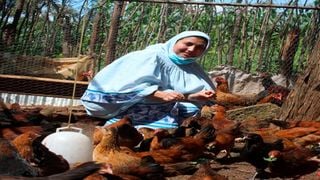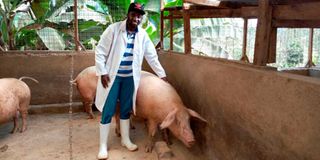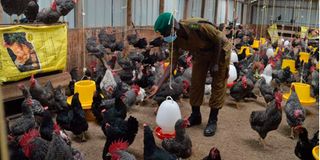
Tasmin Yaseen, a poultry farmer in Eldoret town. She now free-ranges her birds to cut high cost of feeds.
| Stanley Kimuge | Nation Media GroupSeeds of Gold
Premium
Farmers on the brink as cost of livestock feeds hits sky-high
What you need to know:
- Rising cost of animal feeds pushes cost of production three-fold for farmers.
- Some farmers have given up, others have scaled down their operations.
Jesse Ngugi, a medical doctor, quit the profession in 2016 after practising for about a year to venture into pig farming.
Over the years, the farmer who invested Sh2 million into the business – the bulk which came from his father – has been having it rosy.
His farm located in Kaharati, Murang'a County hosts over 600 pigs and has been supplying the animals to Farmers Choice.
But the thriving business now faces the biggest threat since he started as the cost of commercial feeds go through the roof.
In the last two months, animal feed prices have increased by up to Sh500 for a 70kg bag hurting many farmers.
“I know that if you want to succeed in livestock farming, good breeds and feeds are key,” says Ngugi, the proprietor of Pema Pigs Farm.

Dr Jesse Ngugi on his pig farm in Kaharati, Murang’a County.
“But with the continuous rise in the price of feeds, how does one maintain the good breeds for better results?”
Before Covid-19 struck the country, a 70kg bag of pig feeds ranged from Sh2,200 to 2,400 at most.
“Today, the same bag costs from Sh2, 600 to 2,800 yet the price of pigs has not increased. The farmer has to shoulder the burden, what is unsustainable.”
Dr Ngugi was formulating his own feeds but abandoned the idea due to high cost of raw materials such as maize germ, wheat pollard and sun flower. Initially, he could save up to Sh400 per bag.
“We have not grown as we had wished. My goal was to have 3,000 pigs but this is not possible with the current price of feeds.”
The farmer, who also keeps five Friesian dairy cows, says their feeds have similarly increased with a 70kg bag of concentrates currently going at Sh2,400, up from Sh2,200.
Hundreds of farmers across the country are facing Dr Ngugi’s predicament as the high cost of feeds drives some out of business.
The major driver of the high cost of livestock feeds is the shortage of raw materials that include soya meal and sunflower, according to manufacturers, which are imported from countries like Uganda, Zambia and Tanzania
Kenya National Pig Farmers Association (KENPIFA) says farmers are quitting the business due to the high costs.
“Others are scaling down their activities or temporarily closing shop to escape losses," says Alexander Murithi Kireria, the secretary-general of KENPIFA.
Treatment and feeding of pigs is expensive, according to Kireria.
"Pig rearing relies heavily on commercial feeds because the animals are sensitive to farm-made rations.”
The high prices have hit poultry farmers equally hard. As compared to other chickens, many farmers found broiler keeping lucrative due to faster maturity.
But with feed prices rising amid decline in chicken meat cost, things are also not easy for farmers.
“When I started my venture when the pandemic struck, I was optimistic that it was a matter of time before I recouped my investment. However, over a year later, I have not recouped my Sh100,000 capital," says Lilian Kamau, a poultry farmer in Lanet.
Steve Kamwamu, a poultry farmer in Nyahera, Kisumu County, says he’s been forced to dig deeper into his pocket to buy feeds for his 4,500 layers.
In June, a 50kg bag of animal feeds in the town was being sold at Sh2,300. It rose by Sh100 in July and another Sh200 in August.
The farmer accuses manufacturers of taking advantage of the shortage of raw materials to cash in.
But Jenga Feeds Limited managing director, Dr Manase Wasuna, notes that with shortage of soya bean, cotton seed cake and sunflower cake, prices of feeds will keep increasing.
“Our biggest undoing was the ban on maize importation from countries like Uganda. Again, there is high demand of soya bean in China, what has created global shortage,” says Dr Wasuna.
He notes that manufacturers are currently spending Sh130 per kilo to import soya up from half the cost last year.
He adds that with the expected poor maize harvest this season, farmers should expect more price increases of livestock feeds.
According to the Association of Kenya Feed Manufacturers (Akefema), the feed price situation deteriorated recently when Zambia banned export of soya.
Zambia has been one of the main sources of animal feed ingredients for Kenya thus the ban has disrupted supplies.
“Since the ban, the price of the little available soya has gone up resulting in a sharp rise in the cost of producing feeds,” says Martin Kinoti, the general secretary of Akefema.
According to him, a 70kg bag of dairy meal costs an average of Sh3,400 up from Sh2,500 in August last year, chick mash is retailing at Sh4,200, up from Sh3,250 while layers mash is selling at Sh3,800 from Sh3,100.
Henry Otsyula, the investment chairman at Kenya Dairy Farmers Federation that brings together more than 25 cooperative societies in the country, explains that the situation would be worse next year. “
Already, it is projected that there is reduction in maize harvest due to erratic rains. This is likely to strain the feeds industry, he observes.

A National Youth Service recruit at Tumaini Farm in Nyandarua County feeds chickens.
Otsyula notes that they anticipate reduction in milk production but cautions against importation of milk powder, what will hurt the local dairy industry further.
“We are caught between a rock and a hard place. I urge the government to allow importation of yellow maize for animal feeds. I encourage fellow farmers to plant fodder crops,” he adds.
And as the going gets tougher, farmers are turning to alternatives to bring down their costs. Ruth Koech, a pig farmer from Soy, Uasin Gishu County, says instead of buying a 50kg bag of pig feed for about Sh3,000 in Kenya, she goes to Uganda.
“We buy our feeds from Uganda at Sh1,800 per 50kg and top up with transport cost which is Sh30 per bag. This is cheaper,” says the farmer, who keeps 100 pigs.
James Haro, a pig farmer in Vikwatani, Mombasa County, says he has switched to feeding his pigs with food leftovers from restaurants and vegetable remains from fresh produce markets.
“When I have money, I buy a sack of feeds to feed the animals. But to ensure they don’t go hungry, I give them the food leftovers, “he says.
Jescar Ngome, a poultry farmer, on the other hand, formulates feeds using fresh amaranth leaves, which she mixes with maize bran, wheat bran, omena and shredded coconut.
“So far I haven’t seen any difference in the laying pattern of my layers.”
Justin Magiri, who owns 225 rabbits in Bamburi, Mombasa County, says he supplements commercial pellets with hay and vegetables.
But formulating feeds at home comes with risks. "I sold my chickens to a hotel after making my own feeds but my contract was discontinued as the facility said that their clients complained that the chicken had a strong smell of fish. I realised I had used plenty of fish meal," says Peter Kamau, a poultry farmer in Nakuru Town.
Most poultry farmers mix maize, sorghum, fishmeal, sunflower and in some cases soya beans, but not in the correct rations.
“The other disadvantage of this is that some ingredients like soya beans are scarce and expensive. A farmer thus might not save much,” says Kamau.
For Ngugi, he has leased six acres in Murang'a, where he grows napier grass and maize for his five dairy cows.
“I have been going for maize stalks in Nakuru for silage making and also hay, but this is expensive if you factor in transport costs.”
However, not only farmers are feeling the pinch, animal feed stockiest like agrovets say their sales are going down.
“Poultry farmers are the hardest hit. I have lost about 30 per cent of my customers due to high costs. One told me she slaughtered all her birds, refrigerated them for sale,” said David Njoroge, the proprietor of Grada Farmers Ltd based in Ruiru, Kiambu County.
Antonio David, the owner of the Moiben Connections Limited, an agrovet in Eldoret town, observes that the outlets are experiencing drop in sales following the sharp rise in market prices of feeds.
“Agrovets have been hit harder. Farmers are going for alternatives which will lead to drop in production and compromise on the health of the livestock, in the long-term our businesses will suffer big.”
Reporting by Bozo Jenje, Francis Mureithi, Sammy Waweru, Elizabeth Ojina and Stanley Kimuge





